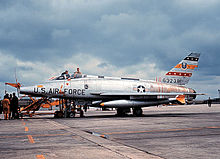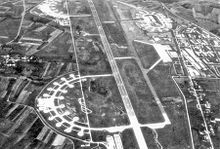Withdrawal of American troops from France
The withdrawal of American troops from France during the Cold War was carried out in two steps. With Operation Red Richard 1959/1960 the nuclear-capable weapon systems have been and with the operation FRELOC 1966/1967 the remaining forces of the United States to Germany and Great Britain laid.
Red Richard
Red Richard was a code name for the US nuclear-capable airborne weapons transfer operation from France .
Political context
With the end of the Fourth Republic and the election of General Charles de Gaulle as President in 1958, the American military presence in France was severely affected. During the crisis in the Middle East , de Gaulle saw right at the start of his term of office how the US, without consulting him, used the French bases to send troops to Lebanon . De Gaulle called for fundamental changes in the power structure of NATO, especially a say in American nuclear weapons. Neither the USA nor Great Britain were prepared to do this, and de Gaulle therefore followed up his words with deeds in the spring of 1959. He detached the French Mediterranean fleet from NATO integration, prohibited the storage of nuclear weapons on French territory and withdrew French participation in integrated air defense.
The administration of President Dwight D. Eisenhower felt compelled to act quickly. The nuclear-armed F-100 Supersaber fighter -bombers of the US Air Force were stationed in France, but regularly patrolled Germany. The American nuclear weapons intended for use were stored at Sembach Air Base in Rhineland-Palatinate ; so a stopover in Sembach was necessary for each mission, a time-consuming and costly procedure.
Course of the operation
Under the code name “Red Richard”, 225 aircraft and 5300 American soldiers with their families were relocated from France to England and Germany within six months , and numerous military facilities were closed:
- 48th Fighter Bomber Wing (FBW) from Chaumont-Semoutiers → RAF Lakenheath (UK),
- 49th FBW from Étain-Rouvres → Spangdahlem Air Base , instead 10th Tactical Reconnaissance Wing (TRW) from Spangdahlem → RAF Alconbury (UK),
- 50th FBW from Toul-Rosières → Hahn Air Base (warheads → Sembach Air Base), instead 38th Tactical Missile Wing (TMW) from Hahn → Sembach,
- Phalsbourg-Bourscheid and Chambley-Bussières were no longer used as alternative places for nuclear orders,
- The logistic facilities in Saint-Nazaire , La Rochelle , Bordeaux , Bussac and Villefranche-sur-Mer were closed.
FRELOC
Operation FRELOC , a contraction of Fast Relocation , was the code name for the complete withdrawal of American forces from France in 1966/1967.
Political context
The rift between France on the one hand and the United States and Great Britain on the other widened. The French rejection of the nuclear Multilateral Force (MLF) enforced by the USA , the expressis verbis veto de Gaulle against British accession to the European Community and finally the development of an independent French nuclear power, the Force de frappe , and the associated doctrine of the Defense à tous azimuts unlike the new Flexible response of NATO , meant that there was a serious decision in the spring 1966th After negotiations about the subordination of American bases in France under French command had remained unsuccessful, de Gaulle asked the NATO allies to move all troops stationed in the country and the international headquarters by April 1, 1967. France will remain a member of NATO, but will withdraw from military integration.
Course of the operation
The French decision affected the alliance as a whole on the one hand, and the USA and Canada with their bases on the other . The positions were completely hardened and further negotiations no longer made sense. The USA began Operation FRELOC on June 15, 1966, and by the deadline it was actually possible to relocate all troops stationed in France and to dismantle the facilities. US Army Europe faced the Herculean task of transporting 813,000 tons of material to England and Germany; 69,000 people had to move. The headquarters COM-Z EUR relocated from Orléans to Worms . The US Air Force was also affected:
- Airport and main depot of Châteauroux-Déols → RAF High Wycombe (UK),
- Operation base Évreux-Fauville → RAF Mildenhall (UK),
- 42nd TRS / 25th TRW from Chambley-Bussières → Takhli Air Base, Thailand ,
- 19th TRS / 25th TRW from Chambley-Bussières → Shaw AFB , South Carolina , Dual Base Sembach (The dual base concept envisaged the deployment in peacetime at an Air Force Base (AFB) in the USA; in the event of a voltage, the squadrons should be moved to specified airfields published in Germany.),
- Reconnaissance aircraft from Laon-Couvron → RAF Upper Heyford (UK),
- 66th TRW from Toul-Rosières → Shaw AFB , South Carolina , Dual Base Ramstein ,
- Central depot Verdun → Miesau .
Effects on the Canadian Armed Forces
The Canadian Air Force relocated its headquarters from Metz-Frescaty to Lahr and the F-104CF- equipped squadron from Marville and Grostenquin initially to Lahr, and in 1970 to Söllingen . In order to concentrate the forces, to end the various subordination of land and air forces (under NORTHAG and CENTAG) and to save costs, the Canadian Mechanized Brigade Group (CMBG) moved from the Soest area to the southwest to Lahr in 1970 and was named CENTAG reserve managed.
Relocation of the headquarters
The political and military headquarters of NATO moved from Paris to Brussels , the European headquarters of the USA from Paris to Stuttgart :
- North Atlantic Council from the Palais de Chaillot , 1955 Porte Dauphine in Paris → Brussels- Evere (BE),
- SHAPE by Rocquencourt near Saint-Germain-en-Laye → Casteau near Mons (BE),
- EUCOM from Camp des Loges near Saint-Germain-en-Laye → Stuttgart-Vaihingen ( Patch Barracks ),
- AFCENT from Fontainebleau → Brunssum near Maastricht (NL).
Effects
After the completion of FRELOC , the majority of the military facilities were in Germany. The American armed forces had to set up a new supply line, Line of Communications (LOC), north of France, which ran from the North Sea ports in Belgium and the Netherlands through Luxembourg to Germany. Only the Central Europe Pipeline System Donges - Metz - Zweibrücken for the supply of fuel remained.
literature
- Pottier, Olivier, Les bases américaines en France (1950–1967), Préface de Maurice Vaïsse, Paris 2003.
- Historical highlights. United States Air Forces in Europe 1942–1997 , Fifty-fifth Anniversary Edition, Headquarters USAFE, Ramstein , Germany, 1997.
Individual evidence
- ^ Cf. Pottier, Bases américaines , 107 f. and Historical Highlights, 73 f.
- ↑ Cf. Pottier, Bases américaines , 126-134 and Historical Highlights, 91 ff.
- ↑ The buildings were used from 1968 by the newly founded Paris-Dauphine University .
- ↑ The buildings erected in 1951 from prefabricated components in Camp Voluceau were used from 1967 - 2016 by the newly founded Institut national de recherche en informatique et en automatique .







